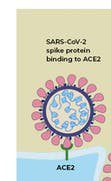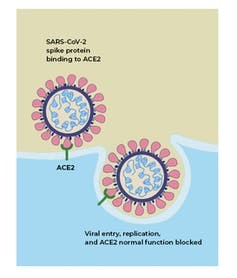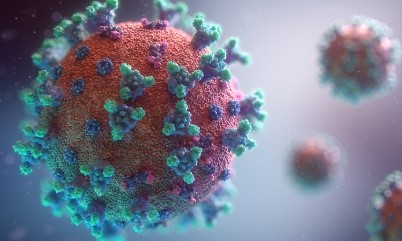Disclaimer: I am not a physician or a virologist. I have a PhD in cell and molecular biology. I did research in medical schools and was part of a clinical trial in a biopharma company. I have grown several viruses and have performed all of the laboratory tests described in this blog.

SUMMARY: Two different tests are required to trace COVID-19 disease. One test looks for viruses, indicating active disease. A different test determines if a person has recovered from the disease by searching for antibodies to the virus.
TESTS FOR ACTIVE DISEASE must detect either the viral genome or the Spike protein. Spike in pink and RNA in blue.
Can these tests be done at home? Pregnancy tests can be done at home, but similar reagents specific for coronavirus are not reliably available at this time.
Can these tests be done quickly in a doctor’s office? Some rapid tests are offered in a doctor’s office, but others must be sent to a lab for more specific testing. Some rapid tests do not have a high accuracy or reliability. They can confirm clinical symptoms, but may not detect low levels of virus in a person. See below RDT (Rapid Diagnostic Tests).
What confirms the presence of coronavirus with or without symptoms? Currently two tests are used. A Genomic test searches for the viral RNA; an Antigen test searches for the Spike protein. The diagram shows internal RNA and external Spikes that bind the virus to lung cells.
Genomic test for SARS-CoV-2 Virus. We see TV crime shows where a drop of blood reveals the identity of the killer in minutes. It works, but just takes more time. First, more copies of the blood DNA must be made. The enzyme DNA polymerase goes back and forth over the DNA chains and makes millions of copies. This is called PCR (polymerase chain reaction) and requires several hours before DNA tests can be performed.
Viral Genomic testing requires one additional testing step. Coronaviruses have RNA, not DNA as genetic material. Viral RNA must first be turned into DNA. RT (reverse transcriptase) turns RNA into DNA and then PCR makes all the copies. This paired test called RT-PCR is extremely accurate. Why is RT-PCR necessary? The viral genome is small. Many copies must be made to be detected in the test. The amount of virus a person has does not indicate how sick they are. Some people breathe out lots of virus, but show no symptoms of being ill. Some people are very sick with low levels of virus.
Antigen test for Spike protein on SARS-CoV-2 Virus. Antibodies to Spike proteins are bound into tiny wells of plastic testing plates. Saliva or nasal swab material is added to the wells. If virus is present in the material, it will stick to the Spike antibodies and register as a positive test.
TESTING FOR RECOVERY FROM COVID-19. What happens when people get well? During COVID-19 disease, the immune system makes antibodies to get rid of the virus. Antibodies are also called immunoglobulins (Ig), and we humans have five different types. Within a few days fighting a disease, the immune system makes IgM. One to three weeks after being ill, white blood cells called B cells make IgG or gamma globulin. Some of these B cells hopefully become Memory B cells. Immunity means you cannot get sick from the virus again.
How should immunity work? Measles vaccine was developed to give lifetime immunity. If you received the vaccine as a baby, there are memory B cells to the virus in your body today. If you are exposed to measles when you are fifty years old, the B cells will rush from their sequestered hiding to start a new assault and destroy the measles virus before it can make you ill.
How do you test for antibodies or IgG? A portion of the Spike surface protein named S1 seems to create the largest immune response. This protein S1 is used in a test called ELISA (enzyme-linked immunosorbent assay). This is the reverse of the test to detect the antigen Spike. Using plastic plates with small wells, the S1 protein is stuck to the bottom of the wells. Then patient serum is added to the wells. If there is IgG to the S1 protein, they will stick together. Several dilutions of the serum will register as a high or low immune response. This test takes several days in a laboratory, but is the best test to determine if you have antibodies.
RDT: How do the rapid tests work? The RT-PCR and ELISA tests are the standards to shorten. Most testing is proprietary, but RT-PCR can be shortened by using a smaller piece of the RNA. A stick antigen test is set up like a pregnancy test. The antibodies to Spike S1 are on the stick. As the nasal fluids flow down the stick, any virus particles will stick and register as a color band. The reverse is again used to test for IgG in recovery. Spike S1 is stuck to the stick. As blood serum flows on the stick, IgG will stick to the Spike S1 proteins.
Does recovery from COVID-19 provide immunity? No one knows. It is not known if a mild case or a severe case provides the same immunity. And if antibodies are produced, no one knows how long they last.
How long do people have detectable virus?No one knows. Some people shed (breathe out) virus for months and feel fine. Normally within two weeks the disease is over, but some have symptoms for months.
Has the virus mutated? Surveys indicate that the European-United States virus strain had a Spike protein mutation back in February-March and is the dominant strain in the US today. This mutation was a single amino acid change that may cause the virus to bind more easily to lung receptors, but does not change any of the antigen or antibody tests.


